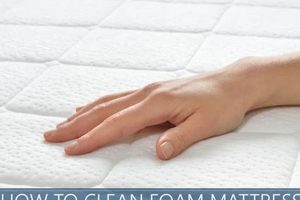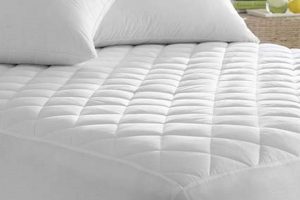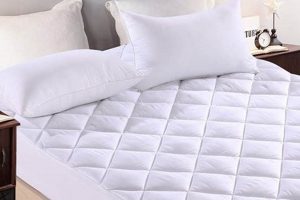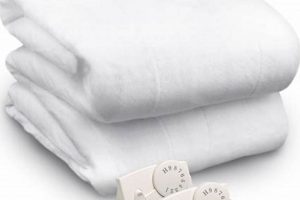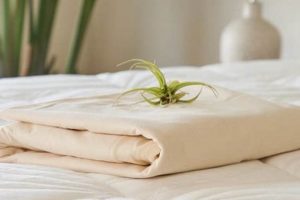These items represent layers of material placed atop a mattress, serving specific functional purposes. They can range from thin, quilted fabrics offering basic protection to thicker constructions incorporating materials like memory foam or down alternatives, designed to enhance comfort. As examples, one might choose a thin cotton layer to safeguard against spills, while another might opt for a plush, memory foam addition to alleviate pressure points.
The utilization of such products addresses multiple needs. Historically, simple mattress covers served primarily as protective barriers. Modern iterations, however, offer advanced features such as improved support, temperature regulation, and extended mattress lifespan. These enhancements contribute to a more restful sleep environment and can be a cost-effective alternative to replacing an entire mattress.
The following sections will delve into the diverse types available, their respective advantages, and key considerations for selecting the most appropriate option based on individual requirements and preferences.
Guidance on Selection and Usage
The following recommendations provide a framework for informed decision-making regarding upper mattress layers. Considerations are presented to optimize comfort and durability.
Tip 1: Evaluate Primary Need: Determine whether the primary objective is protection, comfort enhancement, or support modification. A thin, waterproof layer effectively safeguards against spills, whereas a thicker memory foam structure alters the feel of the underlying mattress.
Tip 2: Material Composition Matters: Analyze the material properties to align with specific requirements. Memory foam offers pressure relief but may retain heat; latex provides responsiveness and breathability; down alternatives deliver a soft, plush feel while remaining hypoallergenic.
Tip 3: Thickness and Loft: Understand that thickness directly correlates with the degree of comfort alteration. A thin layer provides subtle enhancement, while a thicker option will significantly change the sleep surface’s overall feel.
Tip 4: Attachment Mechanism: Examine the attachment method to ensure a secure fit. Elastic straps, fitted skirts, and anchor bands prevent shifting and maintain consistent positioning on the mattress.
Tip 5: Cleaning and Maintenance: Consider the cleaning requirements of different materials. Some are machine washable, while others require spot cleaning or professional laundering. Proper care extends the product’s lifespan.
Tip 6: Consider Mattress Condition: Evaluate the existing mattress’s state before acquiring an upper layer. While it can enhance comfort, it cannot resolve significant support deficiencies in a worn-out mattress core.
Tip 7: Read Product Reviews: Investigate customer feedback to ascertain real-world performance. Focus on comments related to durability, comfort, and any potential issues such as off-gassing or heat retention.
Following these guidelines facilitates an optimized selection process and ensures the chosen product effectively addresses individual needs and preferences, maximizing its benefits. This leads naturally to consideration of specialized applications.
1. Protection
Protection is a primary function served by mattress pads and toppers. These bedding accessories act as a barrier between the sleeper and the mattress core, mitigating damage from spills, allergens, and general wear. Their protective capabilities directly influence mattress lifespan and hygiene.
- Fluid Resistance
One of the most crucial aspects of protection is resistance to liquids. Waterproof or water-resistant materials prevent spills from penetrating the mattress, thereby inhibiting mold growth and staining. For example, a polyurethane-laminated mattress pad effectively shields against accidental nocturnal incontinence or beverage spills, preventing long-term damage to the underlying mattress layers.
- Allergen Barrier
Mattress pads and toppers constructed from tightly woven fabrics or incorporating specialized allergen-blocking membranes create a barrier against dust mites, pet dander, and other common allergens. This is especially beneficial for individuals with allergies or asthma. As an instance, a tightly woven microfiber pad can significantly reduce allergen exposure during sleep, contributing to improved respiratory health.
- Wear and Tear Mitigation
Constant friction and compression from body weight gradually degrade mattress materials. Mattress pads and toppers distribute weight more evenly and absorb much of the surface abrasion, extending the mattress’s lifespan. For example, a quilted cotton pad acts as a buffer, preventing the direct transfer of pressure and friction onto the mattress surface, reducing the likelihood of sagging or indentations.
- Stain Prevention
These accessories serve as a first line of defense against stains from bodily fluids, food, or other substances. This is important not only for aesthetic reasons but also for maintaining hygiene. A stain-resistant treated cover helps make stains easier to remove, maintain better condition and can ensure a cleaner sleep environment.
In summary, the protective functions of mattress pads and toppers extend beyond merely preventing spills. They play a crucial role in maintaining hygiene, minimizing allergen exposure, and mitigating wear and tear, ultimately contributing to a healthier sleep environment and extending the serviceable lifespan of the underlying mattress.
2. Comfort Enhancement
Comfort enhancement represents a significant driver in the utilization of mattress pads and toppers. These accessories directly influence the tactile experience of a sleep surface, offering customizable layers designed to augment or alter the inherent characteristics of the underlying mattress. A mattress that is excessively firm, for instance, can be rendered more yielding through the addition of a memory foam topper, thereby alleviating pressure points and promoting spinal alignment. Conversely, a mattress lacking in targeted support may benefit from a denser latex topper, enhancing contouring and reducing motion transfer. The effectiveness of these alterations hinges on the selection of materials and construction that directly address the perceived deficiencies of the existing sleep surface.
Different materials offer varied degrees of comfort enhancement. Memory foam conforms closely to the body, distributing weight and reducing pressure concentration. Latex provides a more resilient and responsive feel, offering both comfort and support. Down and feather alternatives offer a plush, cushioned surface, prioritizing softness. Consider an individual experiencing chronic back pain; the addition of a gel-infused memor
y foam topper could significantly reduce discomfort by contouring to the spine and minimizing pressure on sensitive areas. Another example is a side sleeper who might find relief from pressure points on their hips and shoulders through the use of a plush down alternative topper.
In conclusion, comfort enhancement is a pivotal element in the selection and deployment of mattress pads and toppers. By understanding the specific comfort needs of the sleeper and carefully considering the material properties and construction of these accessories, a more restful and restorative sleep environment can be effectively cultivated. The integration of comfort enhancement strategies can also extend the lifespan of existing mattresses, providing a cost-effective alternative to complete replacement and the customization for individual sleeper needs.
3. Support Modification
Support modification, as it pertains to mattress pads and toppers, focuses on altering the firmness and contouring characteristics of an existing mattress. This is achieved through the strategic addition of supplementary layers designed to address deficiencies in the original sleep surface, rather than providing basic protection or additional comfort alone.
- Firmness Adjustment
Mattress pads and toppers can effectively increase or decrease the firmness of a mattress. For example, a relatively thin, firm latex topper can be added to a soft mattress to provide more support, particularly for stomach sleepers or those with back pain. Conversely, a memory foam topper can soften an overly firm mattress, alleviating pressure points for side sleepers.
- Zonal Support
Certain toppers incorporate zonal support, which means they offer varying degrees of firmness in different areas. This can be beneficial for individuals who require more support in specific regions, such as the lumbar area, while needing more cushioning in others, like the shoulders. An example is a topper with a firmer center section to promote spinal alignment and softer zones for shoulder and hip contouring.
- Edge Support Enhancement
Mattress edges often lack sufficient support, leading to a feeling of roll-off. Some toppers are designed with reinforced edges to mitigate this issue, providing a more stable sleep surface. This feature is particularly useful for those who sleep near the edge of the bed or who use the edge for sitting.
- Motion Isolation
While primarily a comfort feature, motion isolation also contributes to support by minimizing disturbances caused by a sleeping partner. Memory foam and latex toppers excel at absorbing motion, preventing it from transferring across the mattress. This can result in a more restful sleep, particularly for light sleepers or those sharing a bed with restless partners.
The integration of support modification through mattress pads and toppers offers a cost-effective means of tailoring a sleep surface to individual needs. By selectively enhancing firmness, contouring, edge support, and motion isolation, these accessories address specific deficiencies in the existing mattress, creating a more optimized and supportive sleep environment.
4. Material Composition
The material composition of mattress pads and toppers directly dictates their performance characteristics. The selection of materials influences a range of attributes, including comfort, support, temperature regulation, durability, and hypoallergenic properties. Consequently, understanding the interplay between material and function is crucial for informed decision-making. A memory foam topper, for instance, conforms closely to the body due to its viscoelastic properties, providing pressure relief. However, its closed-cell structure can also trap heat, potentially leading to discomfort for some users. In contrast, a latex topper, whether natural or synthetic, offers a more responsive and breathable sleep surface. The practical implication is that an individual prioritizing pressure relief might choose memory foam, while someone susceptible to overheating would likely favor latex.
The internal structure and density of the materials also contribute significantly. High-density memory foam offers greater support and longevity compared to low-density alternatives. Similarly, the type of fiber used in down alternative fillings impacts their loft and resilience. Consider two seemingly identical polyester-filled mattress pads: one utilizing hollow-core fibers will provide better air circulation and retain its shape more effectively than one filled with solid fibers. Furthermore, the presence of specific treatments or certifications, such as antimicrobial finishes or CertiPUR-US certification, can address concerns regarding hygiene and environmental impact.
Ultimately, the material composition of mattress pads and toppers represents a complex equation with variables influencing the user experience. While a superficial understanding might focus solely on comfort, a deeper analysis reveals the nuanced impact of materials on support, temperature regulation, and long-term durability. Selecting the appropriate material necessitates a careful assessment of individual needs and preferences, guided by a comprehensive understanding of material properties and their respective advantages and disadvantages. Ignoring this aspect compromises the effectiveness and longevity of the chosen product.
5. Attachment Security
Attachment security, in the context of mattress pads and toppers, refers to the method by which these layers are affixed to the underlying mattress to prevent shifting and maintain consistent positioning. Insecure attachment can lead to bunching, slipping, and uneven weight distribution, thereby negating the intended benefits of the pad or topper, such as pressure relief or support modification. The consequences of inadequate attachment range from minor discomfort to significant disruption of sleep quality, especially for restless sleepers or those sharing a bed.
Various attachment mechanisms exist, each with its own strengths and weaknesses. Elastic straps, for example, offer a simple and adjustable solution but may lose elasticity over time or prove incompatible with thicker mattresses. Fitted skirts, resembling fitted sheets, provide a more secure fit but can be challenging to install and remove, particularly on larger mattresses. Anchor bands offer a balance between adjustability and security, but may not be suitable for all mattress types. Selecting an attachment method that aligns with the mattress dimensions and anticipated usage patterns is essential. Real-world examples illustrate this point: a memory foam topper with inadequate elastic straps will tend to slide off during the night, compromising spinal alignment and creating pressure points, while a tightly fitted skirt may prevent a pad from being used on a slightly thicker-than-average mattress.
Ultimately, attachment security is not merely a cosmetic consideration but an integral aspect of the functional performance of mattress pads and toppers. The ability of these layers to remain firmly in place directly influences their capacity to deliver the intended benefits of comfort enhan
cement, support modification, and mattress protection. Challenges remain in developing universal attachment solutions that accommodate the diverse range of mattress types and thicknesses. However, an understanding of the available mechanisms and their respective limitations empowers consumers to make informed choices, maximizing the value and longevity of their bedding investments.
6. Maintenance Requirements
The lifespan and efficacy of mattress pads and toppers are directly contingent upon adherence to appropriate maintenance protocols. Neglecting these requirements diminishes their protective, comfort-enhancing, and support-modifying capabilities, leading to premature degradation and potential hygiene concerns. The composition of these items dictates the specific maintenance regimen necessary, ranging from routine laundering for basic pads to specialized cleaning procedures for memory foam or latex toppers. A failure to address accumulated dust, allergens, and body fluids can transform these bedding accessories into breeding grounds for microbial growth, negatively impacting sleep quality and overall health. For instance, a down-filled mattress pad left uncleaned will gradually lose its loft and insulation properties, while a neglected memory foam topper may develop unpleasant odors and harbor dust mites.
Different materials necessitate tailored cleaning approaches. Machine-washable cotton or polyester pads benefit from regular laundering at recommended temperatures to remove surface debris and allergens. Memory foam toppers, however, typically require spot cleaning with gentle detergents to avoid damaging their structure. Latex toppers may be cleaned with mild soap and water, but require thorough drying to prevent mold growth. Furthermore, direct exposure to sunlight can degrade certain materials, such as memory foam and latex, making it essential to air-dry these items in shaded areas. The consequences of improper cleaning can range from discoloration and shrinkage to irreversible damage, rendering the product unusable. A seemingly minor spill left unaddressed can permeate a memory foam topper, fostering mold growth and necessitating its replacement.
Effective maintenance of mattress pads and toppers is an investment in both sleep hygiene and product longevity. Adherence to manufacturer-recommended cleaning and care instructions is paramount. Failure to do so not only reduces the lifespan and effectiveness of the accessory but also introduces potential health risks. Proper maintenance, therefore, should be viewed as an integral component of ownership, ensuring sustained comfort, hygiene, and value.
Frequently Asked Questions
This section addresses common inquiries concerning mattress pads and toppers, offering clarity on their functionality, selection, and maintenance.
Question 1: What is the primary distinction between a mattress pad and a mattress topper?
A mattress pad typically provides a thin layer of padding, primarily intended to protect the mattress from stains and wear. A mattress topper is a thicker layer, designed to significantly alter the comfort and support characteristics of the underlying mattress.
Question 2: Can a mattress topper correct a sagging mattress?
A mattress topper can provide temporary relief from minor sagging; however, it is not a permanent solution for a severely compromised mattress core. A severely sagging mattress will require repair or replacement.
Question 3: How often should mattress pads and toppers be cleaned?
The frequency of cleaning depends on the material and usage. Generally, mattress pads should be laundered every 1-2 months. Toppers, depending on their construction, may require spot cleaning or professional laundering annually.
Question 4: Are all mattress pads and toppers hypoallergenic?
Not all mattress pads and toppers are hypoallergenic. Those made from materials like natural latex or tightly woven microfiber are less likely to harbor allergens. Individuals with allergies should verify that products are specifically labeled as hypoallergenic.
Question 5: How does the thickness of a mattress topper affect its performance?
Thickness is directly proportional to the degree of comfort and support alteration. A thicker topper will generally provide more significant pressure relief and contouring compared to a thinner option.
Question 6: What are the advantages and disadvantages of memory foam versus latex toppers?
Memory foam excels at pressure relief and motion isolation but may retain heat. Latex offers a more responsive feel, is generally more breathable, and is naturally antimicrobial, but may be more expensive.
In summary, mattress pads and toppers serve distinct functions and require informed selection and maintenance to maximize their benefits. Understanding their limitations and material properties is critical for achieving optimal sleep comfort and mattress longevity.
This understanding naturally leads to the practical aspects of purchasing these bedding accessories.
Mattress Pads and Toppers
This exposition has explored the multifaceted roles of mattress pads and toppers, from their protective capabilities and comfort enhancement to support modification, material composition, attachment security, and essential maintenance. A comprehensive understanding of these factors is vital for informed consumer choices. The selection of an appropriate product hinges on a clear assessment of individual needs, preferences, and the characteristics of the existing mattress.
Ultimately, the strategic utilization of mattress pads and toppers represents a practical approach to optimizing sleep quality and extending the lifespan of a mattress. Careful consideration of the information presented herein will facilitate well-reasoned decisions, ensuring both immediate comfort and long-term value. Continual advancements in material science promise further refinements in the design and performance of these bedding accessories, underscoring the importance of staying abreast of industry developments.



